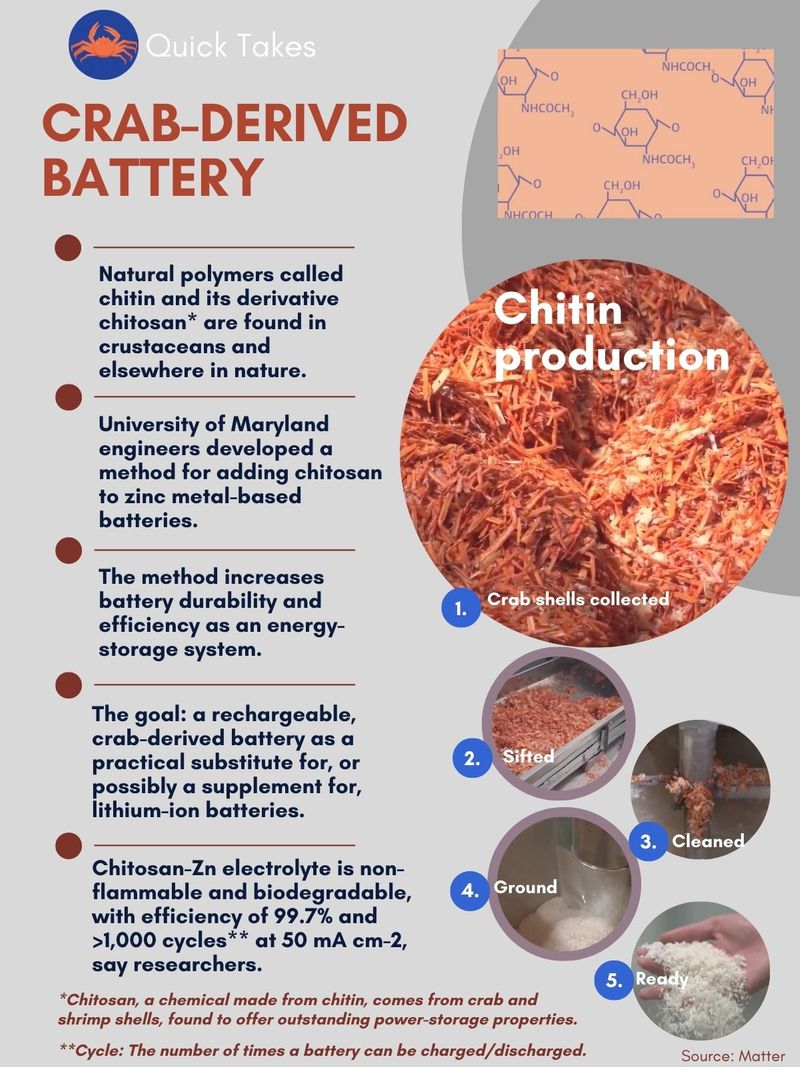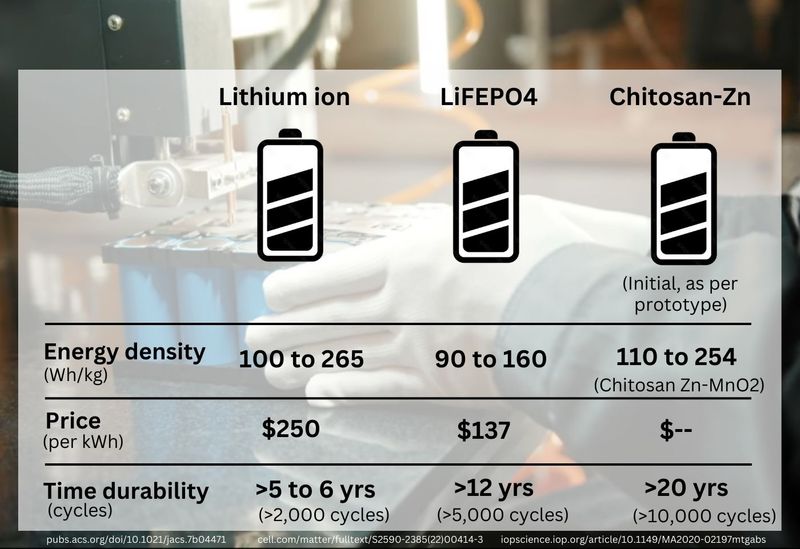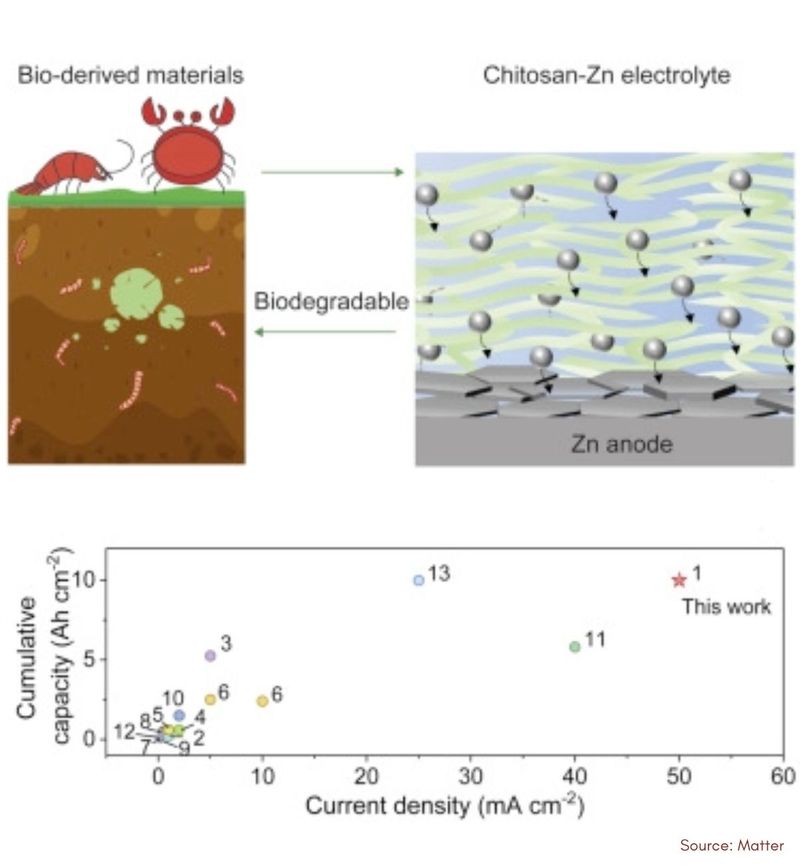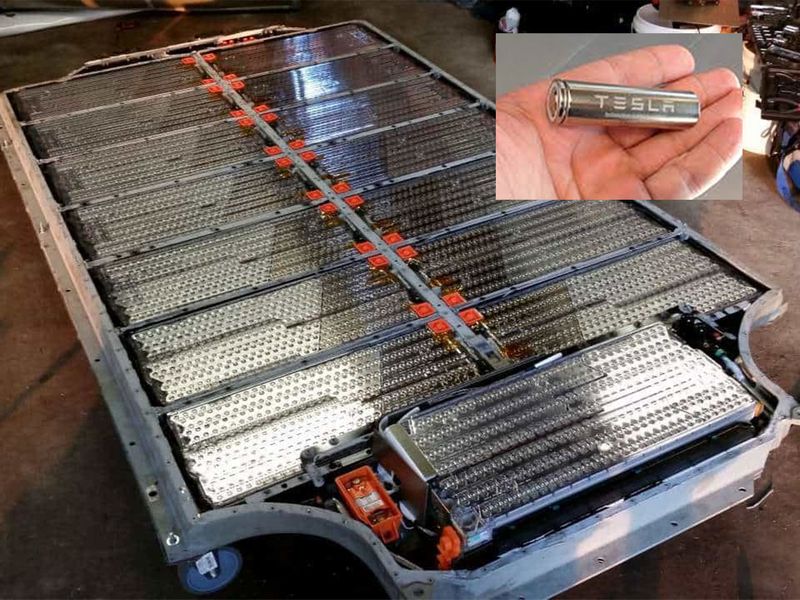
Highlights
- Researchers at the University of Maryland found that battery made from chitosan, derived from crab and shrimp shells, and zinc could be used to create a rechargeable battery.
- Experiments show the new battery chemistry brings a number desirable properties for both mobile and stationary battery applications.
- They are inherently safe, can be recharged up to 10,000 times, and can be safely recycled.
Lithium-ion (li-ion) batteries are ubiquitous, modern-day miracles. They're in your phone, laptop, smart watch, powerbank, drone, EV. Prices have been going down by an average of 20% per year, though raw materials have spiked in recent months. Unknown to many, they use polypropylene and polycarbonate separators, which take hundreds of years to degrade.
Huge quantities of batteries are already being produced and consumed. This upward spiral in production and consumption poses a challenge: as demand for mobile energy storage spikes, so do prices and environmental concerns.
But fret not. To make batteries more sustainable, scientists at the University of Maryland have tried chemicals found in crab and lobster shells, with "remarkable" results.
What is chitosan?
It's not the first time researchers have investigated "Chitosan", a chemical made from chitin — the material found in crab and shrimp shells, known for their unique electro-chemical properties, but are mosty thrown away.

Now, researchers think they hold the key to the next wave of battery manufacturing.
Because of their structure, chitosan-zinc metal batters are inherently safer and easily degrade over time, researchers claim.
“We think both biodegradability of material, or environmental impact, and the performance of the batteries are important for a product, which has the potential to be commercialised,” said Liangbing Hu, the director of the University of Maryland’s Center for Materials Innovation.

“We think both biodegradability of material, or environmental impact, and the performance of the batteries are important for a product, which has the potential to be commercialised.”
Their paper, titled “A sustainable chitosan-zinc electrolyte for high-rate zinc-metal batteries”, was published in the journal Matter on September 1, 2022.

Where chitosan can be used
Here’s where chitosan, a natural polysaccharide (sugary substance), comes in: The water inside a battery, required as a conductor for the ions, corrodes the zinc. This then develops deposits on the anode that interfere with the battery's operation over time.
This explains by zinc-ion batteries typically can’t be charged repeatedly and perform badly.
Positively-charged
It turns out the millions of tonnes of crab shells thrown away from kitchens each year have biomedical uses In 2015, a paper published in Marine Drugs journal pointed to chitosan’s potential pharmaceutical applications.

Chitosan has one property that intrigues battery researchers: it is able form electrostatic complexes — or multilayer structures — with other negatively-charged synthetic or natural polymers.
In a chitosan-zinc battery, fewer water molecules should be available to react with the zinc, as chitosan's molecules bind to water rather well. This potentially reduces the likelihood of zinc corrosion — the reason Hu and his fellow researchers investigated it.
To produce chitosan, chitin shells from the exo-skeleton of shellfish, including crab, lobster, shrimp and other crustaceans need treatment with an alkaline substance, such as sodium hydroxide.
The key benefit: It is cheap, safe, and readily available in nature around the world. It is also biodegradable.
It’s currently used as medicine and in drug manufacturing. It also helps blood clot when applied to wounds.
When used in batteries, the amount of commercially available chitosan powder needed to make a coin-sized cell battery membrane that separates the anode from the cathode is 20 micrograms — or around US 0.00017 cents.
Previous study
It’s not the first time crab shells were investigated for energy storage. In 2020, a team led by Deepa Madan, assistant professor at the University of Maryland Baltimore, published a study in the IOP Science (Institute of Physics) journal, about their experimental rechargeable chitosan-Zinc cells.
The researchers claimed success with multiple cycles of recharging with chitosan-based gel electrolyte, which matched the reported performances of Zn-electrolytic manganese dioxide (EMD) batteries with gel/liquid alkaline polymers. Madan's team then claimed their chitosan-Zinc cell retained up to 97% of energy capacity, and achieved a decent 110 Wh/kg power density.
Stretchable membrane
In the research done by Hu's team, they incorporated chitosan and zinc ions into a stretchable, transparent membrane. They compressed it to a flat, dense state and set over the zinc anode. A substance called as poly(benzoquinonyl sulphide), or PBQS, served as the cathode.
What the tests showed
Test results revealed that the chitosan-zinc ion membrane prevented the typical zinc corrosion in water — while still allowing high, rapid transmission of zinc ions.
Using the technique, researchers found that zinc particles formed small hexagonal platelets that accumulated in flat layers around the anode of the test battery, continuing to aid in reducing unfavourable reactions to the zinc.
Performance
Hu said that over the course of several years, chitosan would progressively deteriorate inside a closed battery, and the leftover zinc could then be recycled.
The prototype made his team outlasted small lithium batteries by operating at a high current density of 50 milli-amperes (mA) per square centimeter for 400 hours — or 1,000 cycles of charging.

Power density: Lithium-ion vs lithium iron phosphate
Due to their high power density of up to 265 watt-hours per kg, lithium-ion batteries are commonly used in laptops, mobile devices and electric vehicles.
So long as there are no defects and the batteries are not damaged, they are generally safe. When damaged, however, lithium ion batteries may present a fire hazard. CNET reports that the odds of a lithium battery fire are about 1 in 10 million.
Life cycle
Most lithium-ion batteries have a life cycle (number of times they can be charged/discharged) of between 500 and 2,000 — in contrast to up to 10,000 cycles of lithium-iron phosphate (LiFEPo4).
In terms of shelf life, LiFePo4 batteries (using iron phosphate cathode and graphite anode) last slightly longer, up to 350 days, than lithium-ion’s 300 days. Moreover, LifePo4 poses no fire/blast risk — though with a lower energy density of 90/160 watt-hours per kg (vs lithium-ion’s up to 265 watt-hours per kg).
More research
Hu cites some of the desirable properties of the chitosan-Zinc electrolyte: high mechanical strength, conductivity and water bonding capability. Their prototype also shows high-rate performance, stable long-term cycling, and is both non-flammable and biodegradable. This makes the solution inherently safe and sustainable, he claims.
Battery technology is advancing fast. Besides Li-ion and LifePO4, there are several teams investigating other solutions — such as polymer batteries (Polyjoule), zinc-cerium redox flow battery (RFB) and liquid metal batteries (Ambri).
If they prove workable supplements to Li-ion and LiFePo4, battery prices could see a huge drop, ushering in a tsunami of demand, thus accelerating the world’s transition towards renewables.
The goal is that a rechargeable, crab-derived battery may be a practical substitute for, or possibly a replacement for, lithium-ion batteries, which are in greater demand as the world progresses toward a more sustainable future.







